by Tufail Ahmad
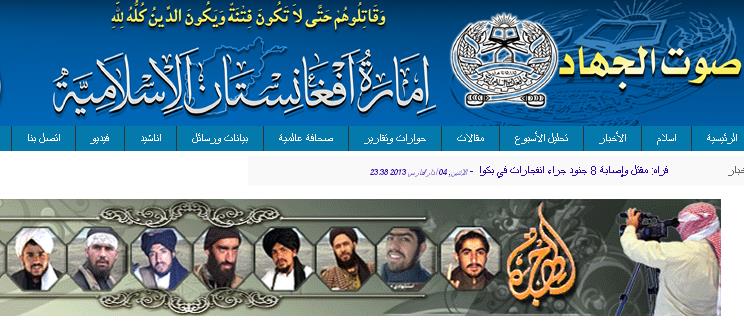 IntroductionThe Islamic Emirate of Afghanistan, the Taliban's shadow government in the country, operates a network of websites and social media accounts to connect with potential jihadists, report the Taliban activities in Afghanistan, and advance the cause of global jihad by means of audio, video text and PDF documents. Most of these websites and social media accounts are hosted in foreign countries such as Malaysia, Singapore, and the U.S. In recent years, various Taliban websites have been hacked by foreign intelligence agencies, but they invariably reappear after a few days.The Islamic Emirate is a formidable jihadist organization led by Mullah Mohammad Omar, who is believed to be in hiding in Pakistan. Mullah Omar is regarded as Emir-ul-Momineen, or the leader of the faithful, by almost all jihadi groups worldwide. The Islamic Emirate is the largest terrorist organization in Afghanistan, followed by Hizb-e-Islami Afghanistan led by fugitive terror mastermind and former Prime Minister Gulbuddin Hekmatyar. Some of the key languages in which the Taliban media outlets disseminate the message of jihad are Pashtu, Arabic, Urdu, Farsi, and English, attracting global audiences. On a day-to-day basis, these web-based media outlets report the activities of Taliban fighters in Afghanistan. These jihadi publications also source their content frequently to Zabihullah Mujahid and Qari Yousaf Ahmadi, the two main spokesmen of the Islamic Emirate. This paper reviews details of the major Afghan Taliban websites and their hosting and domain registration details, as well as their accounts on social media sites such as Twitter, Facebook, and Google, among others.[1] It should be borne in mind that the Taliban's latest video and audio publications are released generally first by Arabic-language jihadi forums such as Al-Fida' and Ansar al-Mujahideen Arabic Forum (AMAF). The Taliban's Jihadi Websites And Their AudiencesSix leading websites that propagate the Afghan Taliban's jihadi activities are: shahamat-urdu.com, shahamat-english.com, shahamat-arabic.com, shahamat-farsi.com, shahamat.info, alsomod-iea.info, shahamat-movie.com, among others. These websites are at the forefront of reporting the Taliban attacks on U.S. and NATO forces as well as jihadi propaganda material.All the Taliban websites' logos include the title "Voice of Jihad," and all of them cross-promote each other and classify their content in the following categories: news, commentaries, interviews, poems, audios, videos and the like. Although the Islamic Emirate says that the Taliban's focus is limited to Afghanistan geographically, its operation of these websites in a number of languages indicates that it is courting supporters and likely jihadists from across the world. The Urdu-language website shahmat-urdu.com also publishes Shariat, a monthly magazine produced in PDF form, and also recently published on the Internet, to reach audiences in Pakistan and northern India where Urdu is the Muslims' primary language. The Pashtu-language shahamat.info, previously shahamat-pashto.com, reaches audiences in Afghanistan and the Pakistani border tribal region, where Pashtu is the main language. The Farsi-language shahamat-farsi.com is aimed at speakers of Dari, a variation of Persian spoken in Afghanistan, and at audiences in Iran. The Arabic-language shahamat-arabic.com reaches a vast audience across the Middle East. The Arabic team of the Islamic Emirate's media team is also very active. Most interviews with the Taliban commander appear first in Arabic and are then translated into other languages. It also produces Al-Somood, an Arabic-language journal. The English-language shahamat-english.com is aimed at the global media and potential jihadi sympathizers across the world, but is primarily aimed at tapping alienated Muslim youth in America and Europe. Leading Taliban Websites Hosted In Malaysia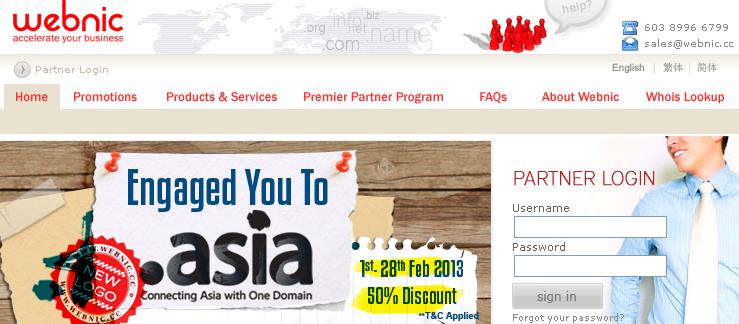 Most of these websites are registered through Webnic, which identifies itself as "the leading ICANN accredited Registrar in Asia with offices in Kuala Lumpur, Singapore and Taiwan. We focus on offering our partners low pricing in gTLDs and many ccTLDs. Serving over 1,600 reseller partners in over 60 countries and managing over 750,000 domain names, [we] currently rank [as] Top 30 registrar in the world."[2] All of the above-mentioned domains are registered by Adil Madani, who gives his home base as Kandahar in Afghanistan, email as adilmadani@yahoo.com, and phone number as +937.34343456, which may or may not be correct. Internet searches for shahamat-urdu.com, shahamat-english.com, shahamat-arabic.com, shahamat.info, and shahamat-farsi.com show similar registration details. For example, the registration, billing and contact details for shahamat-urdu.com are as in the image below:[3] 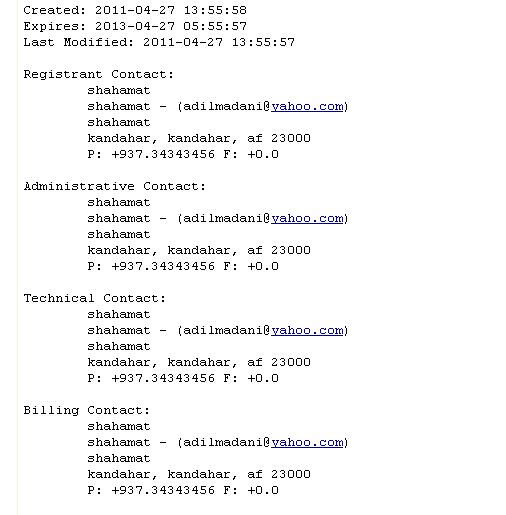 Prior to recent hacking attacks against them, these websites were registered through domain registration and hosting companies based in the U.S. and Canada. Currently, these websites are hosted by Malaysian firm SKA Technology Sdn Bhd, whose address is: 24 & 24A, Jalan Cerdik, Taman Connaught, 56000 Cheras, Kuala Lumpur, Tel: 603-91005371, email skatech@skatech.com.my. SKA Technology identifies itself as "a specialist in the system integration, design and installation of security systems."[4] The domain registration and hosting details are as above for all the Taliban sites. The hosting details for shahamat-urdu.com, as an example, can be seen in the image below:[5] 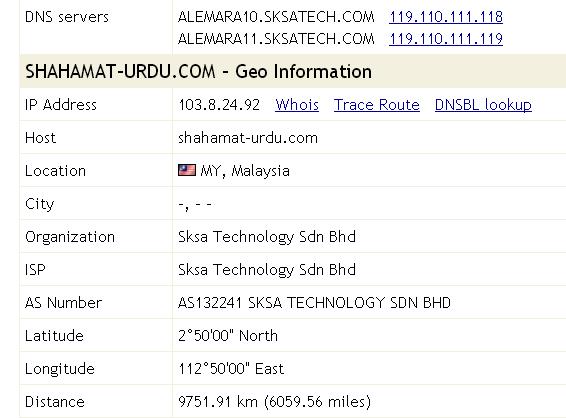 The Taliban's Al-Somood Website – Registered By U.S. Firm, Hosted In Singapore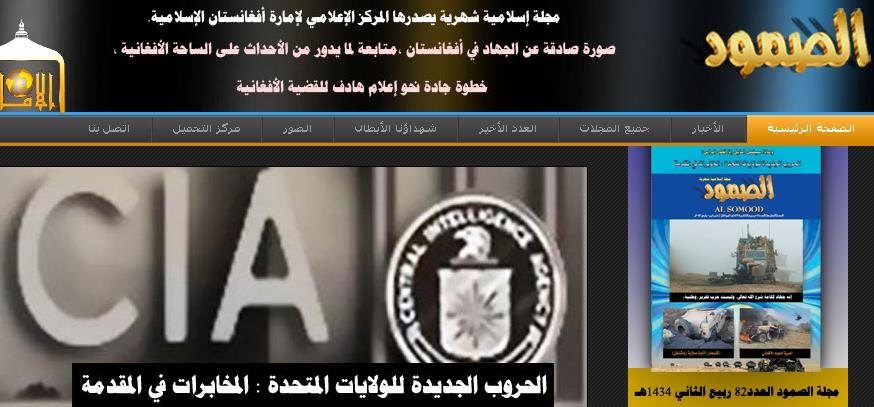 A search for Al-Somood, an Arabic-language magazine that is generally first to interview leading Taliban commanders, reveals that it too is registered by Adil Madani. However, its domain name is registered by Godaddy.com, a U.S.-based firm.[6] As seen in the image below, Al-Somood's website, alsomo-idea.info, is hosted by Vodien Internet Solutions Pte Ltd, a web solutions firm that gives its address as 40C Hong Kong Street, Levels 4 & 5, Singapore 059679, Tel: + 6562886264.[7] 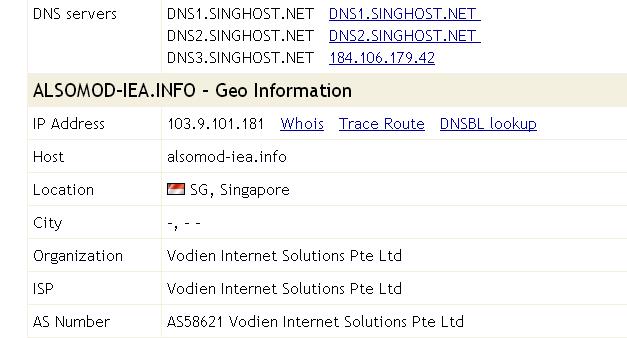 Afghan Taliban Twitter AccountsIn an April 2012 interview with the London-based Arabic-language daily Al-Sharq Al-Awsat, Taliban spokesman Qari Yousaf Ahmadi discussed the Taliban strategy of winning the hearts and minds of Muslim youth through social media tools, stating: "Praise be to Allah, I use computers and have accounts on Facebook, Twitter, and YouTube."[8] A review indicates that Facebook is more active than Google and Twitter in removing the Taliban accounts. However, Twitter has for now allowed the Taliban to continue to use its service.Over the past few years, Taliban militants have opened a number of authentic accounts on the micro-blogging site Twitter. Some of the Twitter accounts affiliated with the Islamic Emirate are: @malhamah, @zabihullahmujahid, @Qariyusufahmadi, @alsomood, @alemarahweb, @GhazniwalTariq, @NaSiH_G, @ABalkhi, @alemarahweb, and @samishinwari1.[9] Of these, three accounts are most important: @zabihmujahid, the official account of Zabihullah Mujahid, and @Qariyusufahmadi, belonging to Qari Yousaf Ahmadi; the two are main spokesmen of the Islamic Emirate of Afghanistan. They publish numerous weblinks via Twitter that lead readers to jihadi content on different websites. A third one, @ABalkhi, is perhaps the most active Twitter account of the Afghan Taliban and has engaged in dueling with NATO officials on Twitter.[10] Also noteworthy is @malhamah, which is named after a jihadi magazine of the same name. It began tweeting on March 4, 2012, posting links to jihadi material on the Internet. Unlike other Taliban accounts, it posts the bulk of its material in Urdu, while some tweets are in English. As of February 7, 2013, it had posted 500 tweets and had 101 followers.[11] The Afghan Taliban's Use of Google's Picasa Photo-Sharing Service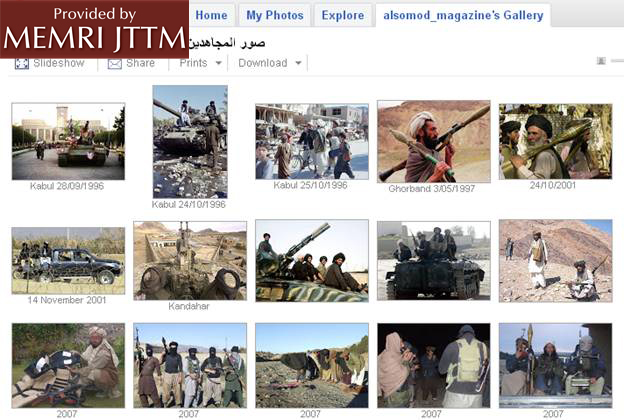 In a December 11, 2012 paper, this author examined how the Islamic Emirate has been using Google's free picture-sharing service Picasa to publish and share images of U.S. soldiers deployed in Afghanistan.[12] Two Taliban accounts, Alsomood100 and Alsomood101, were opened on Picasa in the name of Al-Somood, the Arabic-language magazine of the Islamic Emirate. Thousands of images posted by the Taliban on Picasa are only of jihadi fighters but are also of wounded U.S. soldiers, with the aim of advancing the Taliban propaganda claim that the militants are winning the war against America in Afghanistan. The two accounts feature images of U.S. military tanks and other vehicles attacked and damaged by the militants, wounded U.S. and Afghan soldiers being taken to the hospital, coffins of U.S. and Afghan soldiers being carried, images of jihadi fighters described as martyrs, images of Taliban militants fighting and firing missiles, and the like. The images are dated 2001 through 2012, and are identified by the locations and names of provinces where the incidents occurred. The Taliban, like other jihadist groups in the Middle East, are relying heavily on a number of U.S.-based websites with impunity to publish their videos and documents to further the cause of jihad, among them document-sharing website Scribd.com, the collaboration tool Box.com, the free digital library Archive.org, and others. Often, the Taliban post their videos on these American websites and publish a link to them from their own websites. Also, like Picasa, the Afghan Taliban are using Google's video-sharing website YouTube on a large scale. Though occasionally some jihadi accounts are deleted by Google, little progress has been made in deleting online jihadi videos from YouTube, as researched by MEMRI staff.[13] * Tufail Ahmad is Director of MEMRI's South Asia Studies Project.
[1] For a review of Al-Qaeda's Urdu-language jihadi media
outlets on social media, see MEMRI Jihad and Terrorism Threat Monitor report On Facebook, Twitter, And
YouTube, Al-Qaeda's Urdu Forum Promotes Jihad, Educates Pakistani Audiences
About Al-Qaeda Activists In Middle East, February
25, 2013.
[2] http://www.webnic.cc/subsite/
[3] http://dawhois.com/, accessed March 5, 2013.
[4] http://www.skatech.com.my/, accessed March 5, 2013.
[5] http://dawhois.com/, accessed March 5, 2013.
[6] http://www.who.is/whois/http:/
[7] http://www.vodien.com/comm-
[8] MEMRI Jihad and Terrorism Threat Monitor report Taliban Spokesman Discusses The Taliban's Media
Strategy: 'I Use Computers And Have Accounts On Facebook, Twitter, And YouTube;
Winning over the Minds and Hearts of the Masses Who Visit The Websites' Is More
Important, April 17, 2012.
[9] MEMRI Jihad and Terrorism Threat Monitor report Urdu-Language Taliban-Affiliated Twitter Account
Promotes Jihadi Activities, February 8, 2013.
[10] MEMRI Jihad
and Terrorism Threat Monitor report Key Taliban Accounts Active
On Micro-Blogging Site Twitter, October 9, 2012.
[11] MEMRI Jihad and Terrorism Threat Monitor report Urdu-Language Taliban-Affiliated Twitter Account
Promotes Jihadi Activities, February
8, 2013.
[12] MEMRI Jihad and Terrorism Threat Monitor report Use Of Facebook, Google, And Twitter By Taliban And
Other Jihadi Groups, December 11,
2012.
[13] MEMRI
Jihad and Terrorism Threat Monitor report MEMRI Tests YouTube's
Flagging Feature For Videos Of Yemeni-American Al-Qaeda Leader Anwar Al-Awlaki,
One Year After His Death – The Results: 111 Out Of 127 Remain Active, November 30, 2012.
| |
Tufail Ahmad is Director of MEMRI's South Asia Studies Project.
Source:http://www.memri.org
Copyright - Original materials copyright (c) by the authors.
No comments:
Post a Comment